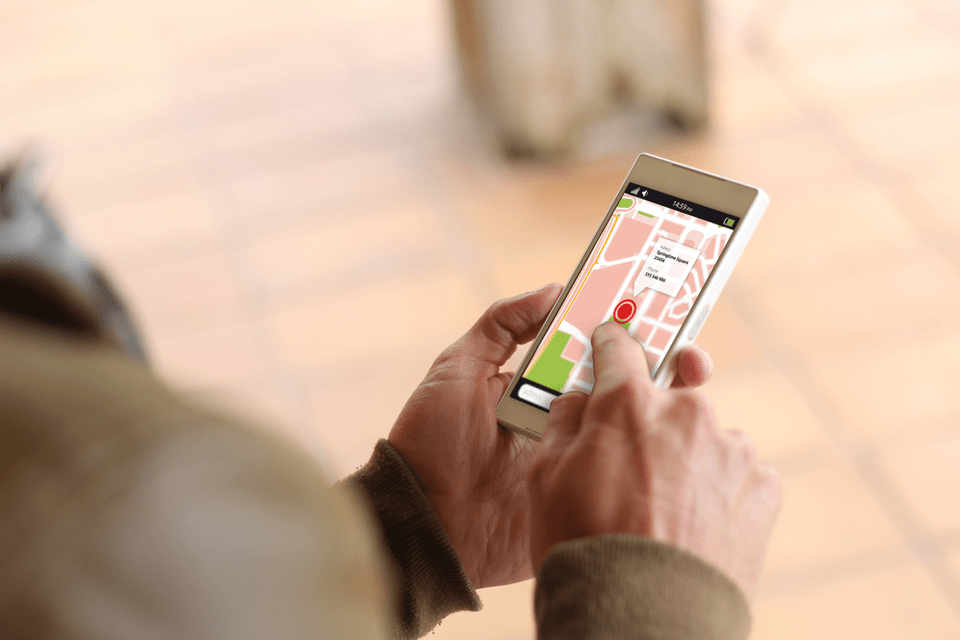
GPS Trackers for Seniors With Dementia: Helpful Bracelets, Watches, and Other Devices

Older adults with dementia can sometimes feel lost, anxious, or disoriented, and these emotions may cause them to leave their room or home in search of something familiar. This is called wandering, or elopement, and is a common but potentially dangerous symptom of Alzheimer’s disease and other forms of dementia in seniors. If your loved one wanders, a GPS tracker can help you find them quickly — and prevent emergencies and potentially dangerous situations.
Let our care assessment guide you
Our free tool provides options, advice, and next steps based on your unique situation.
Key Takeaways
- GPS trackers for people with dementia can help keep them safe. If your loved one wanders, having access to their location can prevent potentially dangerous consequences.
- Dementia tracking devices are wearable and compact. They can look like watches, bracelets, smartphones, or even shoe insoles.
- Tracking devices for people with dementia don’t have to break the bank. Options are available at a variety of price points, depending on your family’s preferences and needs.
- There are other ways to prevent wandering. If you’re worried about your loved one’s wandering, a secure memory care community can help keep them safe.
How GPS tracking keeps people with dementia safe
GPS tracking has helped people find their way for decades. As with apps for driving directions you use on your smartphone, GPS technology in tracking devices for seniors coordinates with satellites to figure out your loved one’s precise location on the ground.
Today, GPS trackers come in many forms and can be so small that people wear them throughout the day with ease. These trackers allow caregivers to know exactly where an elderly loved one is and can help keep them safe.
People refer to tracking devices in many ways. Whether called a GPS tracker for dementia, dementia tracker, dementia tracker watch, or a dementia tracking device, these items all approximately meet the same need: providing another layer of safety for people experiencing cognitive decline who may wander.
What to know about tracking devices for adults with dementia
You can buy tracking devices in many forms. They can be cell phones or, for seniors with dementia symptoms, wearable or attachable accessories. Also, while tracking typically involves GPS, some devices rely on internet, cellular, or radio technology. When researching GPS trackers for dementia, consider the following:
- Activation and subscription fees. GPS trackers often have activation fees, monthly subscription fees, or other costs. Be sure to compare costs and find one that fits your needs and budget.
- Bundle packages. GPS trackers are multifunctional. Look for add-ons, such as fasteners, emergency calling technology, or fall detection, to find a suitable package for your loved one.
- GPS-tracking range. Some GPS-tracking devices have nationwide coverage, while others have worldwide coverage. Research each device’s tracking range to ensure it meets your needs.
Now that you know how to approach your search, here are some useful and discreet tracking devices for dementia patients to keep on your radar, ranked from most expensive to least.
Wearable GPS trackers for dementia patients
There are many wearable options for dementia trackers. GPS tracking devices can be worn inside a shoe, as a watch, on a belt, as a bracelet, on a keychain, and more.
4G GPS SmartSole shoe insert from GTX
The 4G GPS SmartSole is a rechargeable tracking device sealed in a water-resistant shoe insert that can be trimmed to shoe size. By setting up an account on GTX’s website, families can have access to the following features:
- Location History
- Customizable boundary zones
- Email or text message alerts
The SmartSole works wherever T-Mobile 2G coverage is available, although you don’t need to be a T-Mobile customer to use the device. The SmartSole has a battery life of one to two days with normal use, and it even alerts caregivers by email or text notifications when the battery is low.
Cost: The insert is $359, and its related data plan starts at $29.95 a month.
Project Lifesaver’s PLI-PR1 Perimeter alarm system
Project Lifesaver’s alarm system involves a non-GPS device and is known to be one of the easiest-to-use items on this list. No apps or touchscreens are involved, as a wristband worn by the senior simply transmits a radio signal to a handheld receiver that stays with the caregiver. When the senior leaves the “safety zone” — about 100 feet indoors and up to 300 feet outdoors — an alarm sounds on the receiver to alert the caregiver.
To get the alarm system, caregivers have to enroll seniors in the Project Lifesaver organization locally. Project Lifesaver works with certified public-safety agencies like fire and rescue teams, first responders, and law enforcement. In a crisis, a trained emergency team can respond to a caregiver’s area, with recovery times averaging about 30 minutes.
Cost: The Project Lifesaver equipment package — receiver, transmitter, and wristbands — can be purchased through a local Project Lifesaver agency. Prices may vary, but some agencies list the annual cost at $300.

Let our care assessment guide you
Our free tool provides options, advice, and next steps based on your unique situation.
AngelSense device and wearables
AngelSense’s specialized tracking technology offers a wide range of benefits and utility to caregivers. The following features can be accessed through a smartphone app synced with the device:
- Real-time mapping
- An “unknown place” alert
- All-day monitoring
- First-responder emergency alerts
One of its most unique tracking features is one- or two-way voice tools that enable caregivers to hear the user’s surroundings or speak with their loved one. In addition to the handheld device, AngelSense also has wearable trackers that can be fastened onto clothing, like on a sleeve, belt, or shirt.
Cost: The AngelSense kit containing the tracking device and fasteners is listed for $229. There’s a service plan starting at approximately $33 a month, plus an activation fee.
GPS-tracking smartwatches
The easiest way to track your loved one is with something they wear on a daily basis, like a watch. Modern technology allows many watches to double as GPS-tracking devices to help caregivers and family members track the movements of dementia patients in their care. Dementia tracker watches can also help track your senior’s health with features that monitor heart rate, sleep, and more.
Simple and easy-to-hide GPS trackers for dementia
If wearing a GPS tracker is out of the question, there are also options that can be inserted into a wallet or a bag, attached to a lanyard or keychain, or simply placed in a pocket.
PocketFinder Smart Tracker
The PocketFinder Smart Tracker uses GPS, Wi-Fi, and cellular information to locate users. The device, just like the keyless entry remote control for a car, is small and fits easily on a key chain or in your pocket — plus it’s waterproof. Users can log in online or through a mobile app to view the following information from the tracker:
- GPS location
- Address
- Altitude
- Distance from a chosen address
- The device’s movement speed
- 60 days of tracking history
The PocketFinder app gives updates through email and text notifications. PocketFinder also alerts you when the device leaves a specific “geo-fence zone” that you can create.
Cost: The device alone is $99, with an annual service plan starting at $129, for a total of $228 a year.
iTraq Nano
iTraq bills itself as the world’s first global location device. It uses cell towers to determine location, enabling it to be used anywhere around the world where there’s cell service.
The iTraq Nano device itself is about half the size of most smartphones and easily slides into a pocket or connects to a key chain. A mobile app reports the Nano’s location with time stamps. iTraq also features a “Guard Zone,” where users specify a radius on a map and receive alerts if the iTraq goes beyond the pre-set radius.
Cost: iTraq’s Nano is $129, with a service plan costing $59 annually.
Bay Alarm Medical Alert Button
The Bay Alarm Medical Alert Button is a lightweight, ultra-compact device that can be attached to a lanyard or placed in a convenient carrying case. Using Bay Alarm Medical’s app, caregivers can look up the user’s location at any moment as well as check on battery life. In a crisis, the patient can click a button, and Bay Alarm Medical’s response team will contact the user’s friends, family, or neighbors — they can even notify local emergency services if needed.
If wearing a GPS tracker is out of the question, there are also options that can be inserted into a wallet or a bag, attached to a lanyard or keychain, or simply placed in a pocket.
PocketFinder Smart Tracker
The PocketFinder Smart Tracker uses GPS, Wi-Fi, and cellular information to locate users. The device, just like the keyless entry remote control for a car, is small and fits easily on a key chain or in your pocket — plus it’s waterproof. Users can log in online or through a mobile app to view the following information from the tracker:
- GPS location
- Address
- Altitude
- Distance from a chosen address
- The device’s movement speed
- 60 days of tracking history
The PocketFinder app gives updates through email and text notifications. PocketFinder also alerts you when the device leaves a specific “geo-fence zone” that you can create.
Cost: The device alone is $99, with an annual service plan starting at $129, for a total of $228 a year.
iTraq Nano
iTraq bills itself as the world’s first global location device. It uses cell towers to determine location, enabling it to be used anywhere around the world where there’s cell service.
The iTraq Nano device itself is about half the size of most smartphones and easily slides into a pocket or connects to a key chain. A mobile app reports the Nano’s location with time stamps. iTraq also features a “Guard Zone,” where users specify a radius on a map and receive alerts if the iTraq goes beyond the pre-set radius.
Cost: iTraq’s Nano is $129, with a service plan costing $59 annually.
Bay Alarm Medical Alert Button
The Bay Alarm Medical Alert Button is a lightweight, ultra-compact device that can be attached to a lanyard or placed in a convenient carrying case. Using Bay Alarm Medical’s app, caregivers can look up the user’s location at any moment as well as check on battery life. In a crisis, the patient can click a button, and Bay Alarm Medical’s response team will contact the user’s friends, family, or neighbors — they can even notify local emergency services if needed.
Cost: The Bay Alarm Medical Alert Button currently costs $79, plus a $30 monthly subscription fee with an additional $10 a month if you choose to add fall detection.
The Bay Alarm Medical Alert Button currently costs $79, plus a $30 monthly subscription fee with an additional $10 a month if you choose to add fall detection.
Best-selling dementia trackers on Amazon
If you’re looking for highly reviewed GPS trackers with fast shipping, Amazon is the way to go. Take a look at the best-selling dementia trackers on Amazon:
LandAirSea 54 GPS Tracker
Among Amazon dementia trackers, the LandAirSea 54 GPS Tracker is the No. 1 seller. This waterproof, magnetic GPS-tracking device can attach to vehicles, fit in small pockets, or be hidden in a bag. The device uses Google Maps for tracking and offers real-time location that can be viewed by caregivers online or via the SilverCloud app. It can be particularly helpful for older adults who still drive. It offers the following useful tracking features:
- Location and boundary alerts
- Speed alerts
- Battery alerts
- History of locations and idle time
Users can also share their location by sharing a link via text message. The LandAirSea 54 is known to be dependable, with 6-foot tracking accuracy.
Cost: The listed price on Amazon is $29.95. Users must also pay $19.95/month for the subscription.
Tracki
Tracki is a GPS tracking device with worldwide coverage. This small and lightweight device works anywhere with any network. It comes with a built-in SIM card, strong fixture magnet, waterproof cover, belt clip, key chain, and lanyard. Tracki’s alerts and features include the following:
- Up to five days of battery life
- Real-time tracking refreshed every one to five minutes
- Boundary alerts
- Movement alerts
- Battery alerts
- SOS panic button
- Five years of tracking history
Family members and caregivers can track their elderly loved one’s location with Tracki’s app. If real-time tracking isn’t needed, the dementia tracker will track only one to three times per day, resulting in battery life that can last for 30 to 75 days.
Cost: On Amazon, Tracki is $14.88, with subscription costs starting at $9.95/month.

Talk with a Senior Living Advisor
Our advisors help 300,000 families each year find the right senior care for their loved ones.
What to do when your loved one wanders
Regardless of how convenient modern technologies are, it’s still important for caregivers to plan many ways to help keep senior loved ones safe. Take the following steps if the person you care for begins to exhibit risky wandering behaviors:
- Keep a list of people to call on for help, and have telephone numbers easily accessible.
- Ask family, friends, and neighbors to call if they see your loved one alone anywhere.
- Keep a recent photo and updated medical information on hand for authorities if necessary.
- Keep the home and surrounding areas as safe and secure as possible, and stay aware of dangerous areas like stairwells and bodies of water.
- Try to anticipate places to which your loved one might wander, like a former workplace or house.
- Call 911 if you can’t find your loved one within 30 minutes of searching for them.
Other technologies to keep your loved one safe
GPS trackers for dementia patients have many benefits. They can help you track your loved one’s movements, detect falls, monitor heart rate, and alert emergency authorities. However, using tracking devices isn’t the only way you can utilize technology to care for a senior with dementia.
Consider the following technologies to make caring for your loved one easier and more fun:
- Dementia-friendly cellphones. New and flashy technologies can be overstimulating. Consider finding an easy-to-use cellphone for your loved one to make communication easier.
- Apps designed just for seniors with dementia. If your parent is familiar with smartphones and tablets, try downloading apps that stimulate their brain, track daily tasks, and promote conversation.
- Senior monitoring devices. If you live far away from an aging loved one, or even in a separate household, a senior monitoring device can help you discreetly keep track of their health, comfort, safety, and wellness from a distance.
Research all your options for your loved one with dementia
Creating a safety plan and using tracking technology can help you minimize the dangers of dementia symptoms, specifically wandering. If you know your loved one is at risk, think of scenarios that might create confusion, and figure out ways to stay aware of their whereabouts — a device from the list above may be a solution.
For seniors in the advanced stages of dementia, long-term memory care in a secure environment may be a safer solution. Specialized memory care units generally have professional care in a stand-alone wing or in a secured area of an assisted living facility with 24-hour supervision. The physical layouts of dementia care units are even specially designed to be easy to navigate, which further minimizes the likelihood of wandering.
If you need help finding a suitable option for a loved one with dementia, reach out to a Senior Living Advisor at A Place for Mom for tailored, local advice. They can help you navigate potential home care or memory care options, and their advice is always free.
Key Takeaways
The information contained on this page is for informational purposes only and is not intended to constitute medical, legal or financial advice or create a professional relationship between A Place for Mom and the reader. Always seek the advice of your health care provider, attorney or financial advisor with respect to any particular matter, and do not act or refrain from acting on the basis of anything you have read on this site. Links to third-party websites are only for the convenience of the reader; A Place for Mom does not endorse the contents of the third-party sites.
Make the best senior care decision
Make the best senior care decision